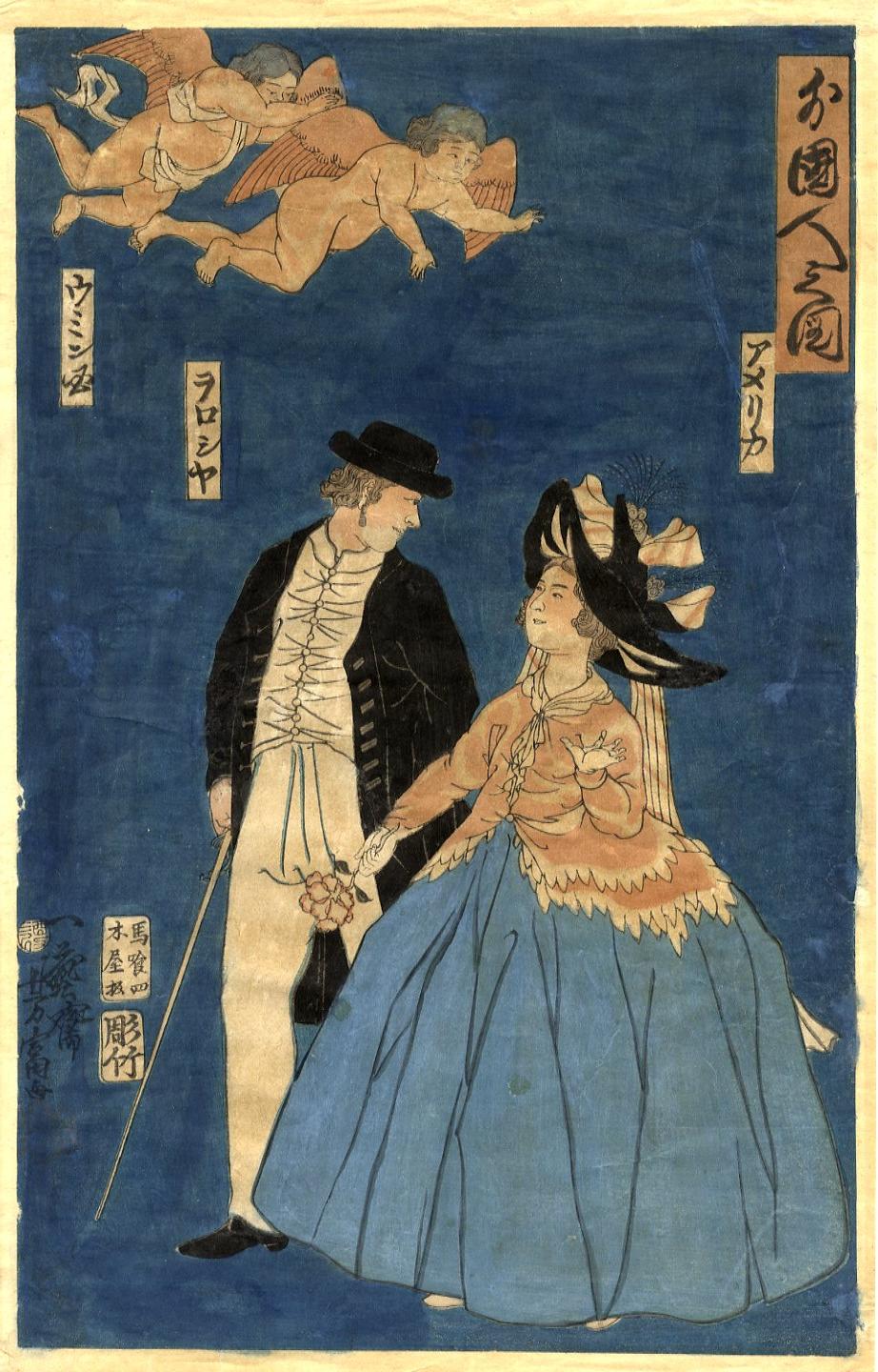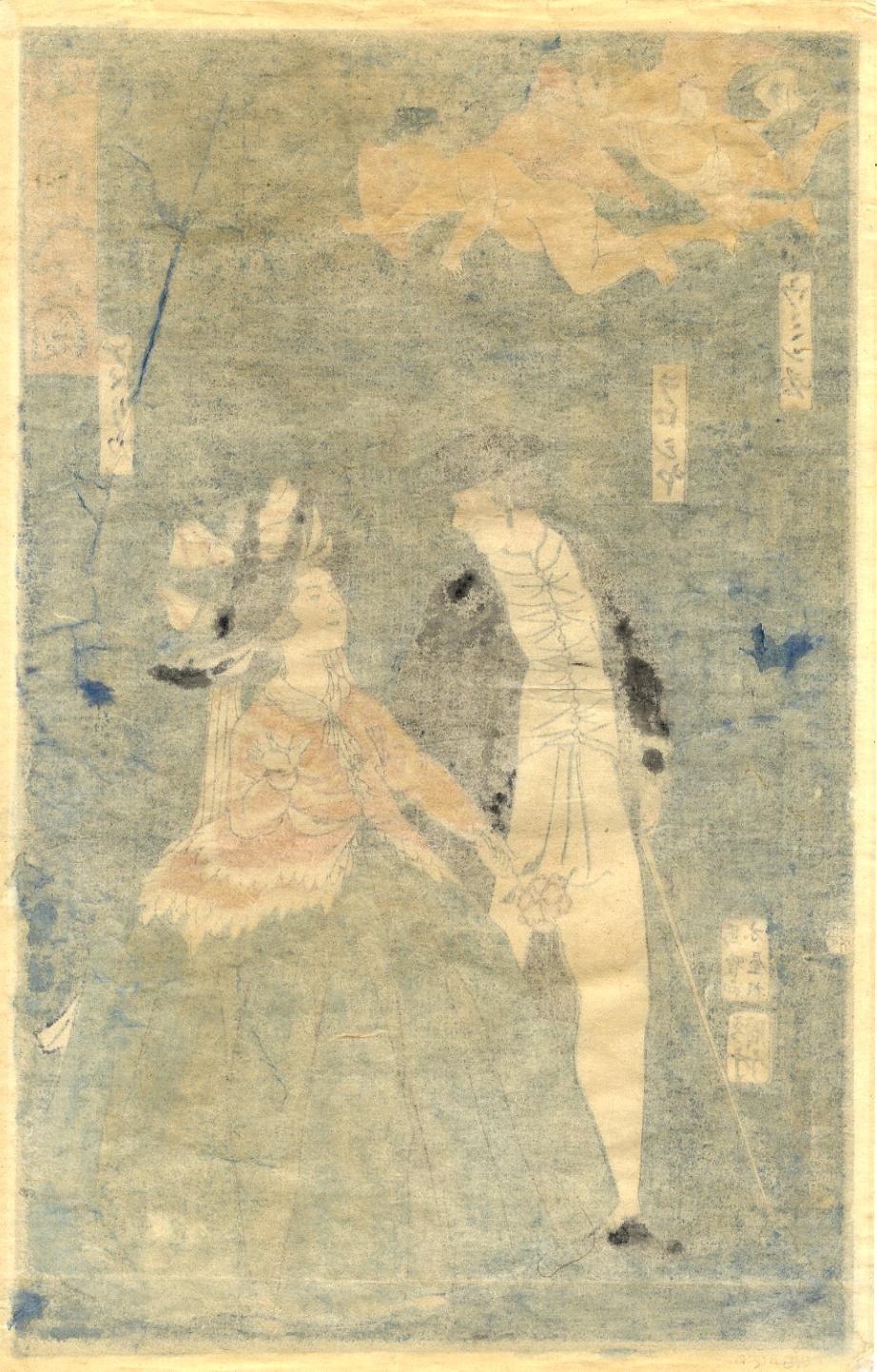Bunkyū 1-3 (1861-04/05) Amerika, Woroshia, Uminkoku The woodblock prints to the right are part of a series of depictions of people from other countries drawn by Yoshitomi in the spring of 1861. Both prints bear approval seals dated the 3rd month of the 1st year of Bunkyū on Japan's lunar calendar, which straddled April and May 1861 on the Gregorian solar calendar. While some foreigner prints show couples or even families from the same country, others show two people from different countries. Here we see a woman from America with a man from Russia in one of the prints, and a Nanking (southern China) woman with a Holland (Dutch) man in the other. Fabulous aliensWhat makes these prints interesting is that, for fun, Yoshitomi included figures from imaginary countries known through fabulous stories and drawings. The main print featured here shows two cherubs from the "Country of winged people" (Uminkoku HÆ). The other print shows two Lilliputian-esque men from the "Island of little people" (Kobitoshima ¬l). Yoshitomi is not making the imaginary people up. He knows about them through the sort of folklore that most people in his line of work would have known about through seeing stories in publications. He could also anticipate that people who might see and buy his drawings also knew the difference between real and imaginary foreign countries -- if they knew very little about them. For more about Uminkoku and other fabulous places and peoples in folklore and on woodblock prints, see "Uminkoku" and other fabulous countries in the article on "Cherubs and banners" in the "Articles" section. Yoshitomi the drawerYoshitomi (Fx) studied drawing under Kuniyoshi as a man named Hagiwara (“). He was eventually given the name Yoshitomi and to gō Ichigeisai (źåYāV). He is said to have moved to Yokohama in 1873 and adopted the name Yoshikuni (FB) and the gō Shinsai (^Ö), hence his signature on works after that as Shinsai Yoshikuni (^ÖFB) or more commonly just Yoshikuni (FF). Horitake the carverThe carver, Horitake, was Yokokawa Takejirō (”ģ|ńY), and he appears to have been active from 1848 to 1864. Many if not most prints acknowledge the person who carved the blocks -- the "artisan" without whom the "artist" would be nothing. Printers were also important, but well design prints needed good composition and colors, and carvers with ability to execute details that the drawer might render on the drawing that the carver used to cut the blocks. Printers could be easily replaced. Good carvers were harder to find, and the better drawers like to partner with the better carvers. Kiya the publishserThe publisher's full name was Kiya Sōjirō (Ų®@Y). Keep in mind that the publishers are equivalent to the producers of a movie. They are in the business of conceiving of a print or series of prints and putting together the teach of artisans, beginning with the drawer and carver, who will design the prints and cut the blocks. Kiya hired Yoshitomi and Horitake, and the unnamed people who made and applied pigments to the blocks and make the impressions that resulted in the multicolor prints. He owned the blocks and finished prints, and sold and otherwise distributed the prints. He would use the blocks to make as many printruns as the market the blocks could bear, cleaning and repairing the blocks as required. He could also sell the blocks to another publisher, who would usually recarve the publisher's name and address before re-publishing -- sometimes with different colors or other design elements. Poor quality of Yosha Bunko copyThe copy in Yosha Bunko is what I refer to as a place holder or space filler. The scan gives the wrong impression of what the print actually looks and feels like. The unprinted border -- too yellowish in the scan -- is odd because it runs around the entire print. And the blues and other colors on the scan appear a bit darker than they do on the actual print. Even without comparing the Yosha Bunko copy with the Philadelphia Museum of Art copy, one might guess that the woman's blue dress had been green. A print designer would not ordinarily makes any element of a drawing so close to the background color. Exposure to light had probably fading out the yellow in the green leaving blue. Red elements in the pink might also have oxidized, making the pink darker than the original. Closer examination of the Yosha Bunko print reveals that it has been heavily restored by a previous owner. The seller disclosed that the print showed some thinning and fading and had been remargined. But it had several other defects that the seller might not have been aware of. Closer inspection of the actual print revealed that the original thin washi been mounted on a piece of stiffer washi -- both to reinforce the print where it had thinned, but also to cover some significant tears and holes. Moreover, the original mimi had been trimmed, radically on the left side, and when pasting the damaged print on backing paper, the restorer created a mimi -- an unprinted margin -- around the entire print, not on just the top and left, where they are usually found -- as seen in the rightmost of the PMA prints to the right. Moreover, in examining the black areas of the clothing of the man and the woman, and the blue background, it is clear that the restorer touched up the colors where there had been tears, holes, and thinning, but applying blue dye to parts of the background, and black dye to places on the man's coat and shoes and the woman's hat. The touching up is easy to see from the back of the print. The background on the front also has a blochy appearance where the blue dye has been applied. The opening of the ports and the arrival of thousands of people from other lands spawned the production of numerous wookblock prints portraying foreigners of different nationalities and scenes of life in the treaty ports. Practically all established artists and disciples drew such prints for local publishing houses, which employed the carvers who chiseled the blocks and the printers who made paper impressions from pigmented blocks. The printing houses owned the blocks and directly sold or distributed the prints. The drawers, like the carvers and printers, were generally hired hands. Unpigmented background variantsThe Uminkoku and Kobitoshima prints had versions with unpigmented backgrounds and other pigment variations. The backgrounds of such prints were made by dedicated blocks, and so long as no other elements were represented on the background block, not printing the block would not have affected the rest of the picture. Pigment changes in other elements of the picture, however, would have require partial recarving -- removing an element from one block and implanting it on another, if not carving a new block. The blue cartouche on the Uminkoku print with the unpigmented background probably required a dedicated block. The changes in the color of the wings of the cherubs (rose / yellow), and in the color of the sash of the cherub (white / green) in the corner, signify changes in the rose, yellow, white, and green blocsk. The color differences on the Kobitoshima prints are more difficult to access because of the possible effects of exposure to light and to ozone and other oxidants in the atmosphere. The lighter blues of the clothing, and the lighter brown of the chair, could have resulted from extreme fading. And the yellow-orange of the country cartouches and the woman's dress, and the rose-pink of the title cartouche and of the woman's clothes and the skins, may have faded to yellow and pink. But fading would not account for the green of the table and the stripes on the woman's dress becoming brown. Greens degrade to blue as yellows fade more than blues in greens composed of blue and yellow. The impression of the unpigmented Uminkoku print does not seem bad in terms of registration and evenness of pigments. But the impression of the unpigmented Kobitoshima print is extremely poor on both counts. Its condition -- grimy, frayed, and a few worm holes -- is another matter. My guess is that the pigmented-background versions came first, and the unpigmented versions came later -- after the blocks had worn and otherwise deteriorated. The original blocks were probably modified to accommodate the changes in colors in the abovementioned picture elements, and the background block eliminated, in order to continue printing the picture while cutting production costs. |
||||||||||||
www.wetherall.org





